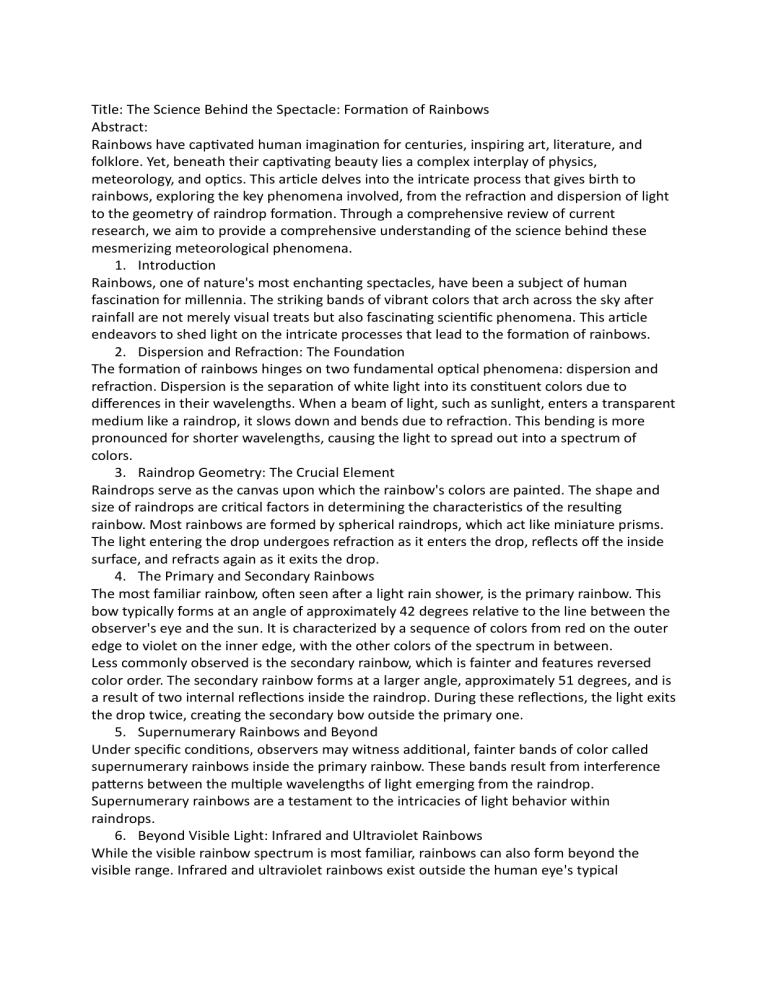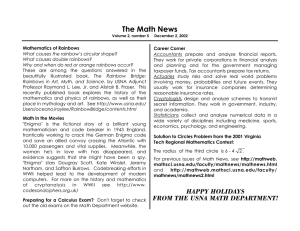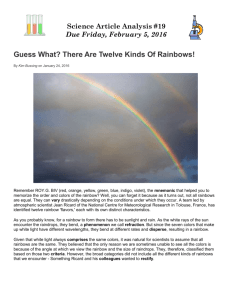
Title: The Science Behind the Spectacle: Formation of Rainbows Abstract: Rainbows have captivated human imagination for centuries, inspiring art, literature, and folklore. Yet, beneath their captivating beauty lies a complex interplay of physics, meteorology, and optics. This article delves into the intricate process that gives birth to rainbows, exploring the key phenomena involved, from the refraction and dispersion of light to the geometry of raindrop formation. Through a comprehensive review of current research, we aim to provide a comprehensive understanding of the science behind these mesmerizing meteorological phenomena. 1. Introduction Rainbows, one of nature's most enchanting spectacles, have been a subject of human fascination for millennia. The striking bands of vibrant colors that arch across the sky after rainfall are not merely visual treats but also fascinating scientific phenomena. This article endeavors to shed light on the intricate processes that lead to the formation of rainbows. 2. Dispersion and Refraction: The Foundation The formation of rainbows hinges on two fundamental optical phenomena: dispersion and refraction. Dispersion is the separation of white light into its constituent colors due to differences in their wavelengths. When a beam of light, such as sunlight, enters a transparent medium like a raindrop, it slows down and bends due to refraction. This bending is more pronounced for shorter wavelengths, causing the light to spread out into a spectrum of colors. 3. Raindrop Geometry: The Crucial Element Raindrops serve as the canvas upon which the rainbow's colors are painted. The shape and size of raindrops are critical factors in determining the characteristics of the resulting rainbow. Most rainbows are formed by spherical raindrops, which act like miniature prisms. The light entering the drop undergoes refraction as it enters the drop, reflects off the inside surface, and refracts again as it exits the drop. 4. The Primary and Secondary Rainbows The most familiar rainbow, often seen after a light rain shower, is the primary rainbow. This bow typically forms at an angle of approximately 42 degrees relative to the line between the observer's eye and the sun. It is characterized by a sequence of colors from red on the outer edge to violet on the inner edge, with the other colors of the spectrum in between. Less commonly observed is the secondary rainbow, which is fainter and features reversed color order. The secondary rainbow forms at a larger angle, approximately 51 degrees, and is a result of two internal reflections inside the raindrop. During these reflections, the light exits the drop twice, creating the secondary bow outside the primary one. 5. Supernumerary Rainbows and Beyond Under specific conditions, observers may witness additional, fainter bands of color called supernumerary rainbows inside the primary rainbow. These bands result from interference patterns between the multiple wavelengths of light emerging from the raindrop. Supernumerary rainbows are a testament to the intricacies of light behavior within raindrops. 6. Beyond Visible Light: Infrared and Ultraviolet Rainbows While the visible rainbow spectrum is most familiar, rainbows can also form beyond the visible range. Infrared and ultraviolet rainbows exist outside the human eye's typical perception but are detectable with specialized instruments. These phenomena provide valuable insights into the dispersion of light across the electromagnetic spectrum. 7. Conclusion Rainbows, those ethereal arcs of color that grace our skies after rain showers, are not merely meteorological curiosities but complex optical phenomena rooted in the principles of refraction, dispersion, and raindrop geometry. The science behind rainbows, from the formation of primary and secondary bows to the occasional appearance of supernumerary rainbows, continues to inspire both scientific inquiry and human wonder. Understanding the intricate processes that give rise to these mesmerizing natural spectacles only deepens our appreciation of the beauty and complexity of the world around us.





